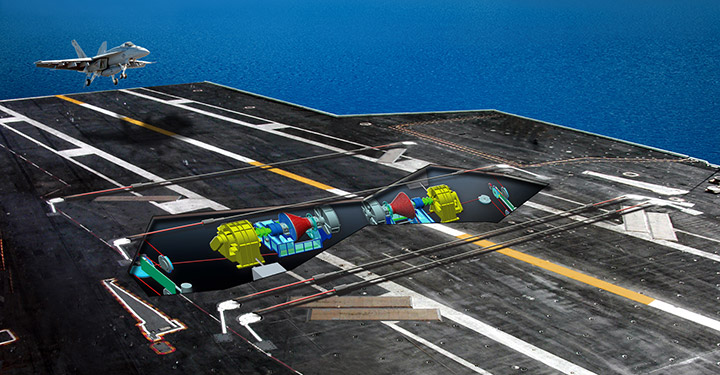
WASHINGTON, D.C. — A design flaw in the system the Navy plans to help safely recover aircraft onboard its next generation Gerald R. Ford (CVN-78) aircraft carrier has set testing for the program back two years and risks extending the delivery of the ship past its March 31, 2016 deadline, Naval Sea Systems Command (NAVSEA) officials told reporters on Thursday.
The General Atomics built Advanced Arresting Gear (AAG) was found to have a design flaw that set testing at Naval Air Station Lakehurst, N.J. back two years, according to the head of Program Executive Officer for Aircraft Carriers Rear Adm. Tom Moore.
“We are about two years behind where we should be up at Lakehurst in terms of having the systems installed and testing it with real aircraft,” he said.
“Right now my major concern on Ford is AAG. I have to get equipment installed. It’s now all arrived at the shipyard. The shipyard is installing the equipment now and concurrently with that I have to get Lakehurst to start testing the upgraded system.”
The flaw was found in the AAG’s water twister — a complex paddle wheel that is designed to absorb 70 percent of the force when the tailhook of a landing aircraft pulls against an arresting wire to come to a stop.
“Doing a detailed engineering assessment we recognized the water twister was under designed,” Moore said.
“GA was responsible for the design — remember they’re on a firm fixed price contract — so the vendor was responsible for the fix.”
Now a newly repaired AAG is under going jet sled tests in Lakehurst while at the same time a separate upgraded version is being installed on Ford.
“We’re a lot more confident the system as it’s currently built will work but it’s important that Lakehurst gets through the jet car test site and we go to a second phase called runway assisted landing system — that’s where they land real aircraft. Those two event at Lakehurst I’ll be watching very carefully,” Moore said.
“If Lakehurst uncovers something on the system that has to be fixed, the risk I’m taking is I’m installing it and then I have to go back and fix something that’s all ready installed, it’s more challenging. Really at this point, I don’t have a choice. “
On the other end of the carrier, the GA built Electromagnetic Aircraft Launch System (EMALS) is doing comparatively better.
“Two of the four catapults are completely built and the other two are almost built and we started below deck testing on what we call the energy storage group in August and we met every key event date for testing on EMALS,” Moore said.
“I’m confident EMALS is progressing on track. The next big event is in the June timeframe when we’ll start shooting dead-load sleds into the James River.”
Absent hang-ups, the $12.9 billion Ford is set to deliver on March 31, 2016. The next ship in the class — John F. Kennedy (CVN-79) — will deliver on June 22, 2022.





